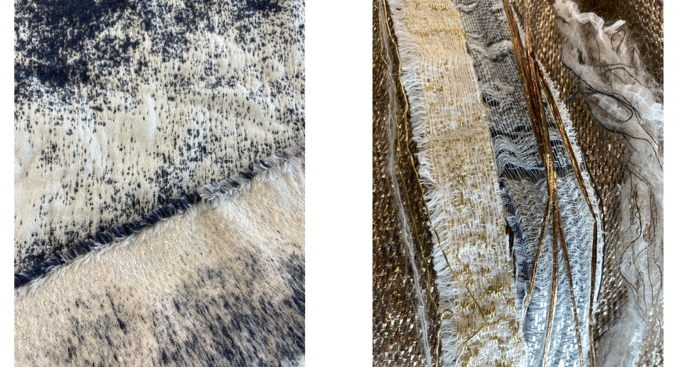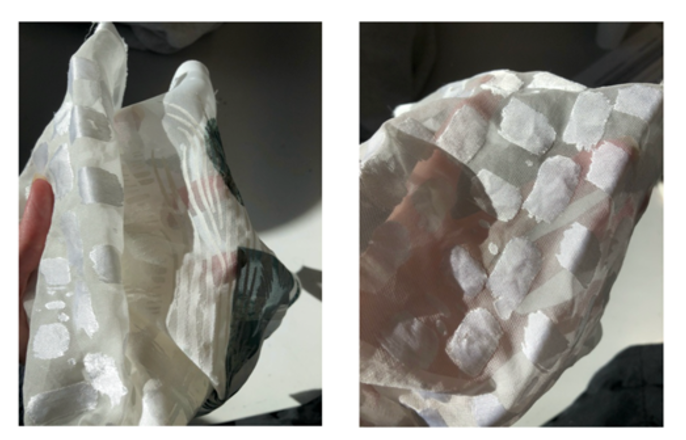Material Empathy.
- Gemma Yeomans

- May 25, 2022
- 4 min read
The term ‘material empathy’ was coined by textile design artist Kristel Laurits who, as part of her Textile Design Master’s Degree, investigated how materiality and sensations relate to emotions. Laurits defines ‘material empathy’ as “an abstract endeavour of perceiving and signifying the encounter through the materiality connecting us” (Laurits, 2019). ‘Material empathy’ is an important part of any artist process as we need to understand the materials physically and mentally, we need to feel material empathy. I recently took part in a collaborative project between my university (University of Wales Trinity Saint David) and Danish artist Jan Koen Lomans. Lomans mailed scraps of tapestry pieces left over from a previous projects and asked us, the students, to create something new with the materials. It was interesting to see how we reacted to the fabrics, not only as artists but as people. The first week of the project, we spent looking upon the luscious, high-quality fabrics. Cautiously picking up the material to inspect the colours and textures. It seemed as though they were too precious, like art in a gallery. Originally, we were afraid to deface the fabrics, to alter them and potentially ruin them. However, when we finally mustered up the courage to slice through the fabrics, we discovered a whole new life to the fabrics. Cutting through the layers of the tapestries, we found hidden gold threads diving in and out of cross hatched white wool, slashes of silver wire cutting through the cobalt blue and thin black threads which held everything together. We could rip apart the layers and see where weaves met wefts and how they intertwined. Our perception of the fabrics had changed, each layer conveying a narrative and each thread telling a story. Without the tactile engagement, we never would have discovered the secret life of these tapestries, the stories tightly woven between layers of wool and mohair. Touch and touching materials allow us to understand them, to empathise with them. But too often we are too afraid or unable to understand materials in this way because of the barriers put up by society, technology and ourselves.

Images showing the deconstruction of Jan Koen Lomans’ textiles
Tactile interactions can ground one in the present. Peter Zumthor links tactility to memories explaining that “sometimes I can almost feel a particular door handle... when I went into my aunts garden... I remember the sound of the gravel under my feet...” (Zumthor, 1998, p.7). Zumthor’s tactile interaction with a doorhandle allows him to reminisce on a particular door handle that he remembered from his aunt’s house. The door handle felt familiar, and this made a memory occur, a comforting confirmation of substance and presence, of the real. This act of stopping and concentrating specifically on one object is often referred to as ‘Mindfulness.’ Mindfulness can be defined as a mental state when you are “paying more attention to the present moment – to your own thoughts and feelings, and to the world around you – can improve your mental wellbeing” (National Health Service, 2018). Mindfulness promotes “awareness [which] comes from simply noticing where we are right now – and how we feel – using our sense doorways” (Davy, 2019, p. 79). Tactility and mindfulness work together closely, allowing a person to concentrate and understand their position in the present. The tacit knowledge is the confirmation of the real. This type of tactile confirmation can also be found in materiality. Materials and textiles can be manipulated, for example, by being dyed, printed on, ruffled and stitched. These manipulation techniques are a reminder of the material’s construction and materiality. In particular, the technique of devore is especially evocative. Handprinted (2014) describes devore as a textile technique “used on mixed fibre material where a paste is used to burn through cellulose fibres, leaving woven fabric behind in a pattern or design”. So, the fibres of the weft are burned away by the devore, leaving a semi see-through result where the paste was applied. This technique alters the structure, essentially the body, of the fabrics. There is a confirmation of life, of a presence of an essence, within the fabric.

Images showing samples of devoré resist on silk satin
There is a “magic of the real, of the physical, of substance, of the things around me that I see and touch, that I smell and hear” (Zumthor, 1998, p.83) and “...there is an imitate relationship between our emotions and the things around us” (Zumthor, 1998, p.85). Using our tactile senses, we perceive an object both externally and internally. Our senses are connected to our emotions. But the modernisation of the world has led towards a senseless world of disconnection. The use of thoughtfulness and consideration of tactility can change this. As we progress, it is essential that we consider tactility in not only our everyday lives but also in a wider sense. We must think carefully about tactility as it can be both beautiful and destructive. Tactility guides us back to reality and underpins our definition of the real and the unreal. Therefore, we must surround ourselves with it and pay attention to it.
Bibliography.
Davy, A. (2019) A sense of place : mindful practice outdoors. London: Bloomsbury Publishing. Driscoll, R. (2020) The sensing body in the visual arts: making and experiencing sculpture. London: Bloomsbury Publishing.
Handprinted (2014) ‘How to Make a Devoré Scarf’, Handprinted [blog]. 20 November. Available at: https://handprinted.co.uk/blogs/blog/how-to-make-a-devore-scarf-1 (Accessed: 30 November 2021).
Laurits, K. (2016) Material Empathy. Available at: https://royaldanishacademy.c om/project/material-empathy (Accessed: 28 November 2021).
National Health Service (2018) Mindfulness. Available at: https://www.nhs.uk/mental- health/self-help/tips-and-support/mindfulness/ (Accessed: 7 November 2021).
Zumthor, P. (2006) Thinking Architecture. 2nd edn. Basel: Birkhäuser.
Gemma Leigh Yeomans
Excerpt from Tactile Realities
Submitted: 10/12/21


Comments